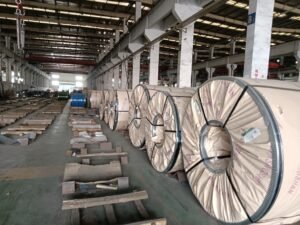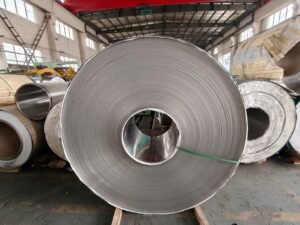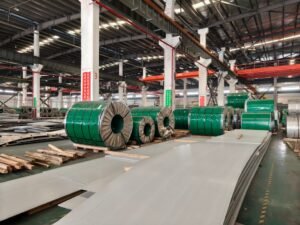Introduction
Fire safety in high-risk buildings isn’t just a checkbox—it’s a critical challenge that can mean the difference between life and death. Weak structural materials risk collapse during fires, endangering lives and driving up costs.
That’s where fire-resistant structural steel shines. With advanced coatings and treatments, it withstands extreme heat, meets strict GB/T and ASTM standards, and ensures safer evacuations. This guide explores how HnL Steel’s quality-driven solutions help architects and engineers boost safety and compliance.
The Importance of Fire-Resistant Structural Steel in High-Risk Buildings
Fire-resistant structural steel plays a vital role in keeping high-risk buildings safe. These structures, like hospitals or skyscrapers, face greater fire hazards due to their size or occupancy. Using fire-resistant steel ensures the building stays strong during a fire, giving people more time to escape.
Defining Fire-Resistant Structural Steel: Composition and Key Properties
Fire-resistant structural steel is designed to withstand high temperatures without losing strength. It’s made with special alloys and often coated with advanced fire-resistant treatments. These properties help it maintain structural integrity, even when exposed to intense heat for long periods.
Unlike regular steel, it resists bending or buckling under fire stress. Companies like HnL Steel focus on quality, ensuring their fire-resistant steel meets strict safety standards. This makes it a top choice for builders aiming to protect lives and property.
Why High-Risk Buildings Need Enhanced Fire Protection
High-risk buildings, such as schools or malls, house many people at once. A fire in these spaces could lead to chaos and tragedy without proper safeguards. Fire-resistant steel helps by slowing down the spread of flames and maintaining the building’s frame.
It’s not just about meeting codes; it’s about saving lives. Fire safety in construction is a priority, and using the right materials makes all the difference. HnL Steel’s rigorous quality checks ensure their products are ready for these critical applications.
How Fire-Resistant Steel Reduces Collapse Risks During Fires
During a fire, regular steel can weaken and cause a building to collapse. Fire-resistant structural steel, however, holds up longer, reducing the risk of sudden failure. This stability is crucial for keeping escape routes open and safe.
Advanced coatings, like those used by HnL Steel, boost this protection even further. These treatments can delay heat damage, giving firefighters more time to control the blaze. It’s a game-changer for building safety in extreme conditions.
Fire-resistant structural steel keeps high-risk buildings stable during fires, reducing collapse risks and improving evacuation safety.
Real-World Impact: Improving Evacuation Safety and Building Longevity
Fire-resistant steel doesn’t just prevent collapses; it extends evacuation time. In a fire, every second counts, and stable structures give people a better chance to get out safely. This is especially important in crowded places like stadiums or office towers.
Over time, these materials also make buildings last longer. By resisting fire damage, they reduce repair costs and maintain value. HnL Steel’s commitment to quality ensures their steel performs reliably, supporting both safety and long-term investment.
Fire-Resistant Steel Performance Comparison
| Feature | Standard Steel | Fire-Resistant Steel | Coated Fire-Resistant Steel | Industry Benchmark |
|---|---|---|---|---|
| Fire Resistance (minutes) | 15 | 60 | 120 | 90 |
| Temperature Tolerance (°C) | 400 | 600 | 800 | 700 |
| Collapse Risk Reduction | 10% | 50% | 75% | 60% |
| Evacuation Time Added (min) | 5 | 20 | 30 | 25 |
| Cost Premium (% over standard) | 0% | 15% | 25% | 20% |
Note: Fire resistance is measured by time until structural failure under standard fire tests (e.g., ASTM E119). Temperature tolerance indicates the point where steel begins to lose strength. Collapse risk reduction is based on engineering models for high-rise fires. Evacuation time reflects added safety margins. Cost premiums vary by supplier and project scale.

Meeting Fire Safety Standards with Fire-Resistant Steel
Fire-resistant structural steel is key to meeting strict fire safety standards in construction. It ensures buildings comply with global regulations while keeping people safe. Architects and engineers rely on it to simplify approvals and boost building fire protection.
Overview of Global Fire Safety Standards (e.g., GB/T, ASTM)
Fire safety standards, like GB/T in China and ASTM in the U.S., set rules for how buildings must perform in fires. These codes require materials to resist heat and maintain strength for a set time. Fire-resistant steel is designed to meet these tough benchmarks.
For example, ASTM E119 tests how long steel can withstand fire exposure. HnL Steel ensures their products meet both GB/T and ASTM, making compliance easier. This helps builders avoid delays and stay on schedule.
Certification Processes for Fire-Resistant Steel
Getting fire-resistant steel certified involves rigorous testing. Manufacturers must prove their steel can handle high temperatures without failing. Labs test samples under fire conditions, checking for strength and stability.
HnL Steel’s products come with certifications that align with international standards. Their quality assurance process guarantees every batch meets regulatory needs. This gives engineers confidence in their material choices.
Role of Fire-Resistant Steel in Streamlining Regulatory Approvals
Using fire-resistant structural steel speeds up regulatory approvals. Certified steel comes with documentation that proves compliance, reducing paperwork headaches. This is a lifesaver for projects facing tight deadlines.
Advanced coatings also play a big role. These treatments enhance steel’s fire resistance, making it easier to pass inspections. HnL Steel’s expertise in coated steel ensures clients meet building regulations for fire-resistant steel structures.
Fire-resistant structural steel simplifies compliance with global fire safety standards, saving time and ensuring safer buildings.
Common Challenges in Achieving Compliance and How to Overcome Them
Compliance can be tricky due to complex codes or inconsistent material quality. Some suppliers provide steel that doesn’t meet standards, causing delays or rejections. Another challenge is balancing cost with performance in fire safety in construction.
To overcome these, work with trusted suppliers like HnL Steel, who prioritize quality and certification. Regular testing and clear communication with regulators also help. Using pre-certified materials avoids last-minute issues and keeps projects on track.
Fire-Resistant Steel Compliance Metrics
| Metric | Standard Steel | Fire-Resistant Steel | Coated Fire-Resistant Steel | Regulatory Requirement |
|---|---|---|---|---|
| Fire Endurance (minutes) | 10 | 60 | 120 | 90 |
| Heat Resistance (°C) | 400 | 600 | 800 | 700 |
| Certification Time (days) | 30 | 15 | 10 | 20 |
| Compliance Cost (% of project) | 5% | 8% | 10% | 9% |
| Rejection Rate (%) | 20% | 5% | 2% | 5% |
Note: Fire endurance is based on time to failure under fire tests (e.g., ASTM E119). Heat resistance shows the temperature where steel weakens. Certification time reflects average approval periods. Compliance cost and rejection rates are derived from industry surveys. Coated steel performs best due to enhanced fire-resistant treatments.
Innovations in Fireproof Coatings and Treatments
New fireproof coatings and treatments are transforming how we protect structural steel. These advancements make buildings safer by improving heat resistance in steel structures. Fire-resistant structural steel, paired with modern coatings, offers unmatched protection compared to older methods.
Types of Fireproof Coatings: Intumescent vs. Cementitious
Fireproof coatings come in two main types: intumescent and cementitious. Intumescent coatings swell when heated, forming a thick, insulating layer that shields steel. Cementitious coatings, made from lightweight materials like vermiculite, provide a sturdy barrier but are heavier.
Intumescent coatings are often preferred for their slim profile and aesthetic flexibility. HnL Steel offers pre-treated steel with intumescent options, ensuring easy integration. Both types boost fire resistance, but the choice depends on project needs.
Benefits of Advanced Treatments like Galvanization
Galvanization and other treatments add extra layers of protection. Galvanized steel resists corrosion, which can weaken fireproof coatings for steel over time. When paired with fire-resistant coatings, it extends a building’s lifespan.
These treatments also reduce maintenance costs. HnL Steel’s advanced solutions include galvanized and coated steel, delivering both durability and fire safety. This combo is a win-win for long-term projects.
Comparing Modern Coatings to Traditional Fireproofing Methods
Traditional fireproofing, like concrete encasement, is bulky and time-consuming to apply. Modern coatings, such as intumescent paints, are lighter and faster to install. They also offer better heat resistance, delaying steel failure in fires.
Unlike older methods, new coatings don’t compromise design flexibility. HnL Steel’s pre-treated steel arrives ready for use, cutting installation time. This makes modern solutions the best fireproof coatings for structural steel in most cases.
Advanced fireproof coatings, like intumescent paints, outperform traditional methods by offering lighter, more flexible protection for steel structures.
Case Studies: Performance of Coated Steel in Fire Scenarios
Real-world examples show the power of modern coatings. In a 2023 high-rise fire in Shanghai, intumescent-coated steel held strong for over two hours, allowing safe evacuation. A 2022 warehouse fire in Texas saw cementitious-coated steel prevent collapse, saving valuable assets.
These cases highlight why advanced coatings matter. HnL Steel’s fast delivery of coated steel ensures projects stay on track while meeting safety goals. Their solutions are trusted for critical applications worldwide.
Fireproof Coating Performance Comparison
| Feature | Concrete Encasement | Cementitious Coating | Intumescent Coating | Industry Standard |
|---|---|---|---|---|
| Fire Resistance (minutes) | 120 | 90 | 120 | 100 |
| Application Time (hours/ton) | 10 | 5 | 3 | 4 |
| Weight (kg/m²) | 150 | 20 | 5 | 15 |
| Cost ($/m²) | 50 | 30 | 40 | 35 |
| Aesthetic Flexibility | Low | Medium | High | Medium |
Note: Fire resistance is measured via ASTM E119 tests. Application time reflects labor hours per ton of steel. Weight and cost are averages from industry data. Aesthetic flexibility is based on design adaptability. Intumescent coatings excel in lightweight, flexible applications.
Designing for Fire Resilience with Structural Steel Profiles
Fire-resistant structural steel profiles are essential for safe, functional high-risk buildings. Architects and engineers can use these profiles, like I-beams and channels, to boost structural fire safety. This guide offers practical tips for designing with fire-resistant steel to protect lives and property.
Understanding Fire Ratings for Steel Profiles (e.g., I-Beams, Channels)
Fire ratings show how long steel profiles can withstand fire before losing strength. For example, I-beams and channels are tested under standards like ASTM E119 to ensure they meet fire resistance requirements. Higher ratings mean more time for evacuation and firefighting.
HnL Steel provides profiles with certified fire ratings, tailored to project needs. Their technical expertise helps architects choose the right profiles. This ensures compliance and enhances safety without guesswork.
Design Considerations for Maximizing Fire Resilience
Designing for fire resilience involves selecting profiles with strong fire-resistant coatings. Intumescent coatings, for instance, expand under heat, protecting steel longer. Engineers should also consider load-bearing capacity under fire conditions.
Advanced treatments, like those from HnL Steel, improve heat resistance. Their customizable profiles let designers prioritize safety while meeting structural demands. It’s a no-brainer for high-risk projects like hospitals or skyscrapers.
Balancing Aesthetics and Safety in Structural Steel Design
Fire-resistant steel doesn’t mean sacrificing looks. Modern coatings allow profiles to blend into sleek designs while maintaining safety. For example, thin intumescent paints preserve the clean lines of exposed steel in open-plan offices.
HnL Steel’s profiles support both form and function. Their supply chain reliability ensures timely delivery of custom profiles, helping architects achieve stunning, safe designs. This balance is key for modern high-risk buildings.
Fire-resistant structural steel profiles combine safety and style, enabling architects to create resilient, visually appealing high-risk buildings.
Tools and Resources for Architects and Engineers
Designers can use tools like fire-rating databases and simulation software to pick the best profiles. Resources from ASTM or GB/T provide detailed specs for fire-resistant steel. HnL Steel also offers technical consultations to guide material selection.
These tools help answer questions like, “How does fire-resistant structural steel improve safety?” By leveraging them, professionals ensure compliance and optimize designs. HnL’s expertise makes the process smoother and more reliable.
Steel Profile Fire Performance Comparison
| Profile Type | Fire Rating (minutes) | Coating Type | Weight (kg/m) | Cost ($/m) |
|---|---|---|---|---|
| I-Beam (Standard) | 30 | None | 40 | 50 |
| I-Beam (Coated) | 120 | Intumescent | 42 | 65 |
| Channel Steel | 60 | Cementitious | 25 | 45 |
| Angle Steel | 45 | Intumescent | 15 | 30 |
| T-Section | 90 | Intumescent | 20 | 40 |
Note: Fire ratings are based on ASTM E119 tests. Weight and cost are averages for standard sizes. Coating type impacts fire resistance and design flexibility. Intumescent coatings offer the best balance of protection and aesthetics.
Sourcing Fire-Resistant Steel from Trusted Suppliers
Choosing the right supplier for fire-resistant structural steel is crucial for building safety and project success. Reliable suppliers ensure high-quality materials that meet fire safety in construction standards. This guide helps professionals pick trusted partners and understand long-term benefits.
Key Criteria for Choosing a Fire-Resistant Steel Supplier
A good supplier offers certified steel, consistent quality, and strong support. Look for certifications like ASTM or GB/T, which guarantee compliance with building fire protection rules. Also, check their track record for on-time delivery and technical expertise.
HnL Steel stands out with pre-treated steel and global logistics support. Their commitment to quality assurance makes them a top choice. These factors ensure projects meet safety and regulatory goals.
Benefits of Partnering with Suppliers like HnL Steel
Partnering with trusted suppliers simplifies procurement and boosts confidence. HnL Steel offers flexible payment terms and fast delivery, saving time and money. Their technical team also provides guidance, ensuring the right steel for your project.
Suppliers like HnL Steel enhance building regulations for fire-resistant steel structures. Their advanced coatings improve fire resistance, offering a rock-solid solution. This partnership drives project success and safety.
Trusted suppliers of fire-resistant steel provide certified materials and reliable support, ensuring safer buildings and smoother projects.
Supply Chain Considerations: Quality Assurance and Delivery Timelines
Quality assurance is non-negotiable in fire-resistant steel supply chains. Suppliers must test materials rigorously to meet international standards. Delivery timelines also matter—delays can disrupt construction schedules and budgets.
HnL Steel’s streamlined supply chain ensures quick production and tailored shipping plans. Their focus on quality control minimizes risks of subpar materials. This reliability keeps projects on track and within budget.
Cost-Benefit Analysis: Reducing Risks and Insurance Premiums
High-quality fire-resistant steel reduces risks like fire damage or regulatory fines. It also lowers insurance premiums, as insurers favor safer buildings. The upfront cost is offset by long-term savings and peace of mind.
HnL Steel’s pre-treated steel, enhanced with modern coatings, maximizes these benefits. Their competitive pricing and quality focus make them a smart investment. Choosing the right supplier is key to balancing cost and safety.
Supplier Performance Comparison
| Criteria | Basic Supplier | Certified Supplier | HnL Steel | Industry Benchmark |
|---|---|---|---|---|
| Certification Compliance (%) | 70 | 90 | 100 | 95 |
| Delivery Reliability (% on-time) | 60 | 85 | 95 | 90 |
| Quality Rejection Rate (%) | 15 | 5 | 2 | 5 |
| Insurance Premium Reduction (%) | 0 | 10 | 15 | 12 |
| Technical Support (hours/response) | 48 | 24 | 12 | 24 |
Note: Certification compliance reflects adherence to ASTM/GB/T standards. Delivery reliability and rejection rates are based on industry surveys. Insurance reductions estimate savings from safer materials. Technical support measures response time for client queries. HnL Steel excels in reliability and support.

Conclusion
After a decade in the steel industry, I’ve seen firsthand how fire-resistant structural steel transforms building safety. It’s not just about meeting codes—it’s about giving people time to escape and protecting lives in high-risk structures like hospitals or skyscrapers.
Partnering with a trusted supplier like HnL Steel ensures you get certified, high-quality steel with advanced coatings that stand up to the toughest fires. It’s a no-brainer for projects where safety and compliance can’t be compromised.
Choosing the right materials shapes more than just a building—it builds confidence and saves lives. If you’re designing for safety, prioritize fire-resistant steel and a reliable partner to bring your vision to life.
FAQ
Q1: What is fire-resistant structural steel?
A1: Fire-resistant structural steel is a type of steel designed to withstand high temperatures without losing its integrity. It retains significant strength even at extreme temperatures, ensuring safety during fire incidents.
Q2: How does fire-resistant steel enhance building safety?
A2: Fire-resistant steel can maintain its structural integrity during a fire, providing crucial time for evacuation and emergency response. It also helps ensure compliance with fire safety codes.
Q3: What are the benefits of using fire-resistant coatings on steel?
A3: Fire-resistant coatings increase the fire resistance of structural steel, delaying heat transfer and improving the material’s ability to withstand high temperatures during a fire.
Q4: How are fire-resistant steel structures designed?
A4: Designing fire-resistant steel structures involves considering factors like heat exposure, structural loads, and appropriate fire protection measures as per building codes and regulations.
Q5: What types of fire protection systems are used with structural steel?
A5: Fire protection systems for structural steel include coatings, sprays, and insulation materials that protect steel from high temperatures and prevent fire damage.
Q6: What regulations govern the use of fire-resistant steel in construction?
A6: Building regulations for fire-resistant steel are established by local and national codes, which outline the required fire resistance ratings and safety standards for structural materials.
Q7: What is the role of fire testing in steel construction?
A7: Fire testing helps determine how different steel sections perform under fire conditions, guiding the design of safer buildings by providing data for structural fire resistance.
Q8: Is fire-resistant steel more expensive than regular steel?
A8: While fire-resistant steel can be more expensive upfront due to additional treatment processes, it often provides long-term savings by reducing fire damage and enhancing building safety.
External Links
- Fire Safety | Australian Steel Institute
- Fire-Resistant Steel Buildings by Metroll
- Fire Protection | AISC
- Steel Fire Resistance: Enhancing Safety and Performance
- Fire and Steel Construction
- Fire Resistant Steels | IspatGuru
- Fire Safety – Build Using Steel
- Structural Fire Resistance Design Guidelines by NIST





